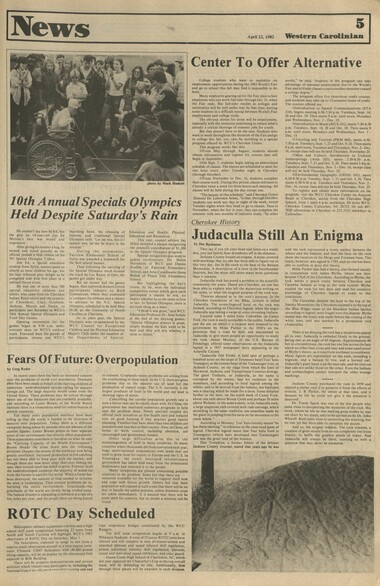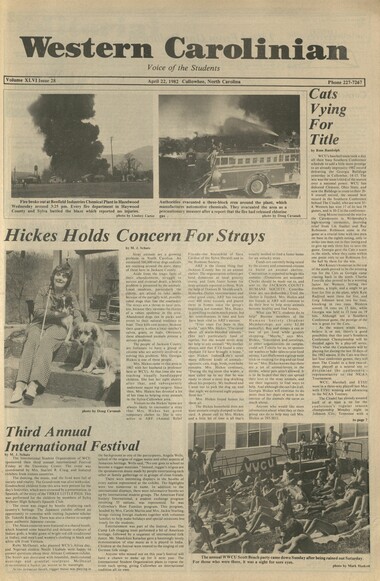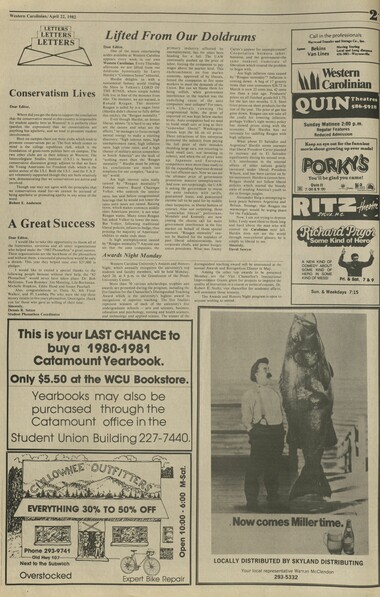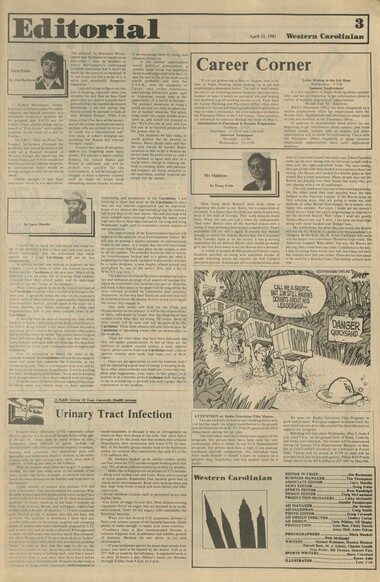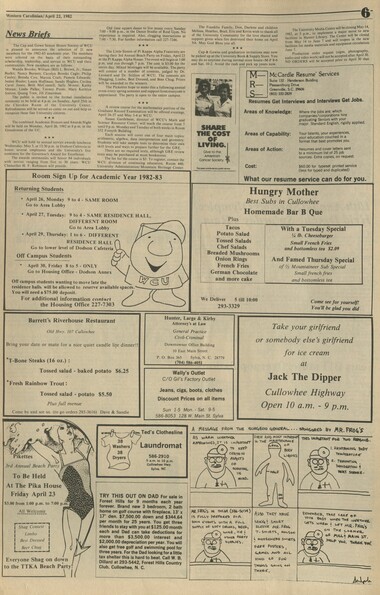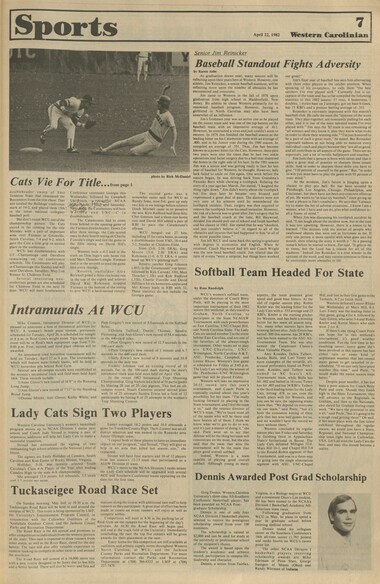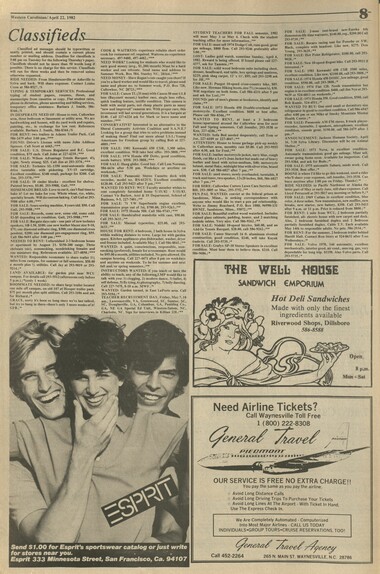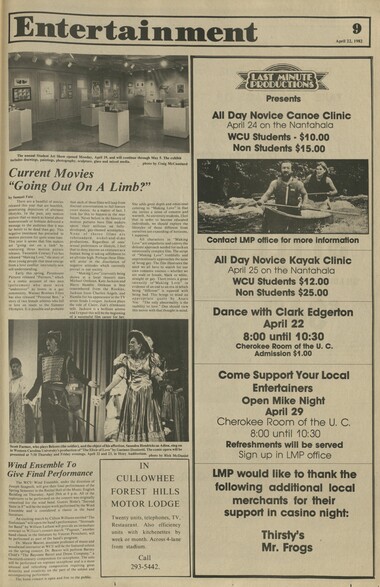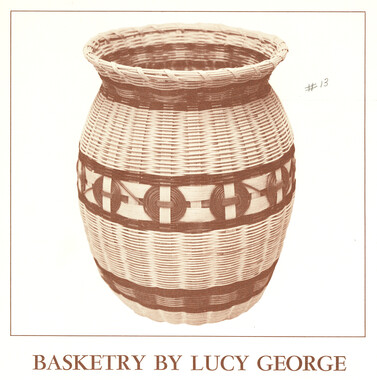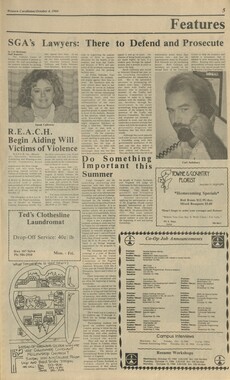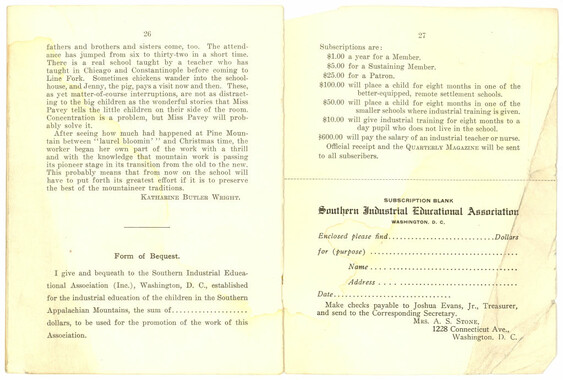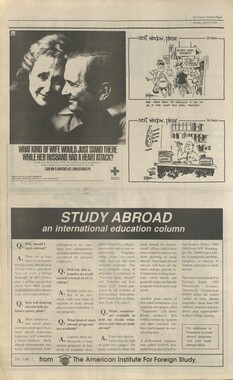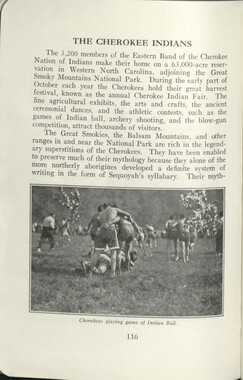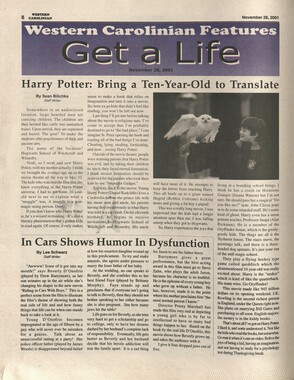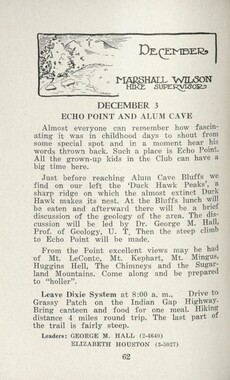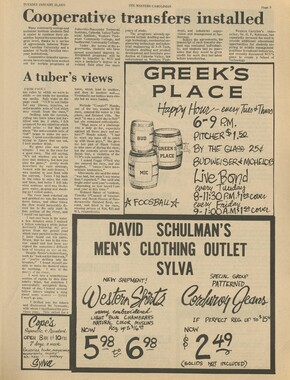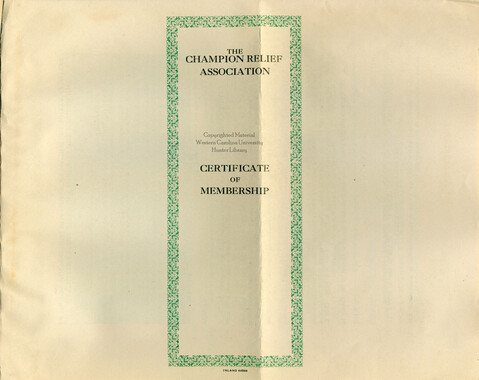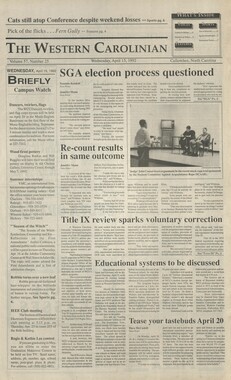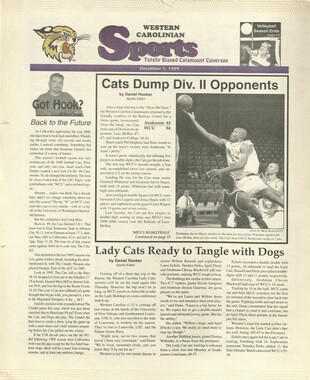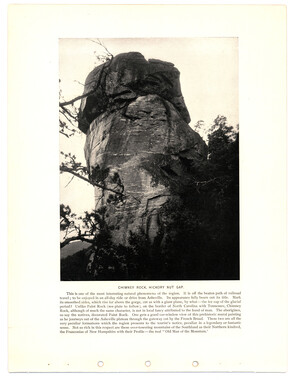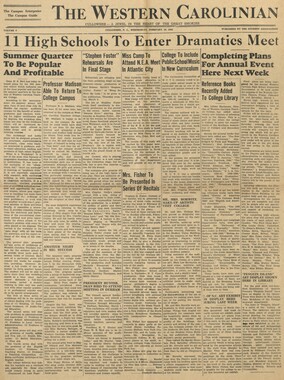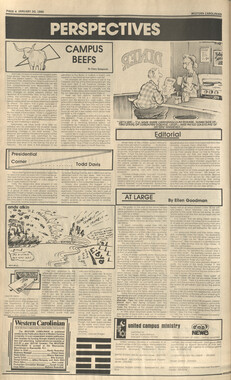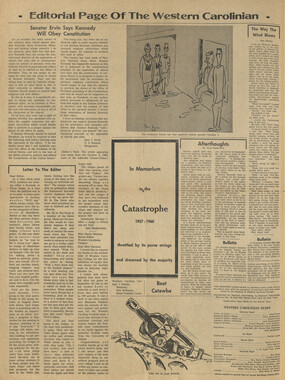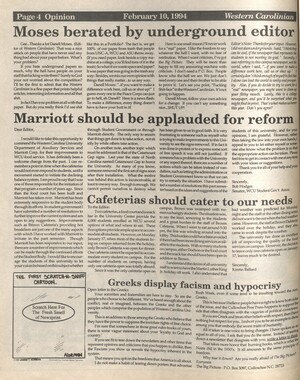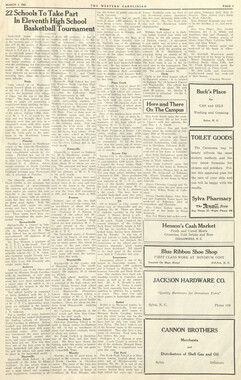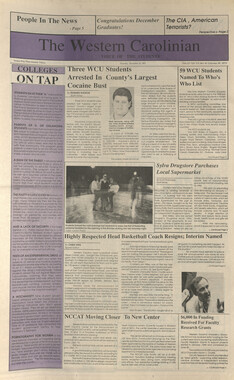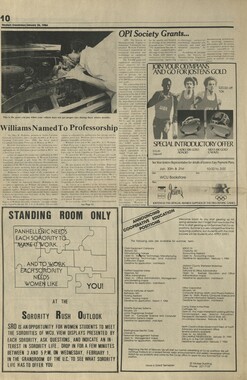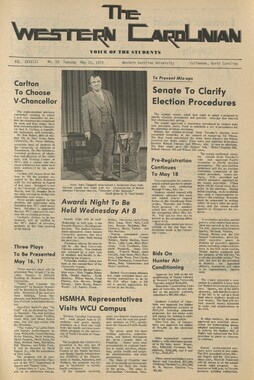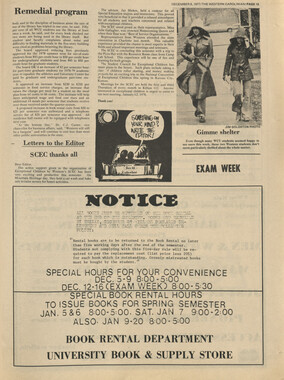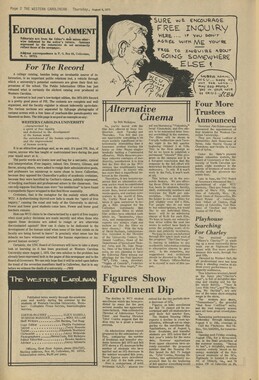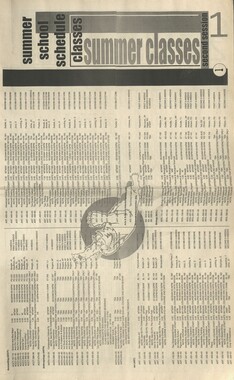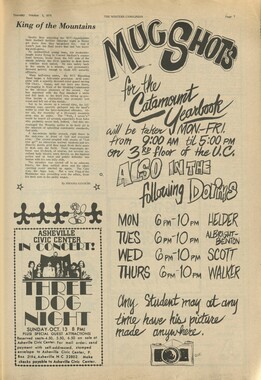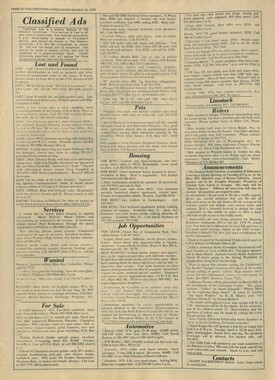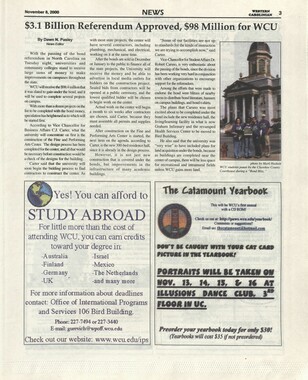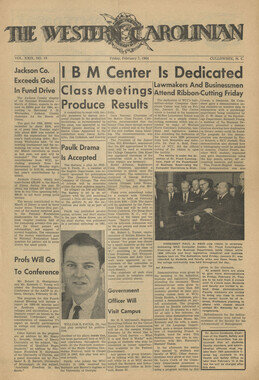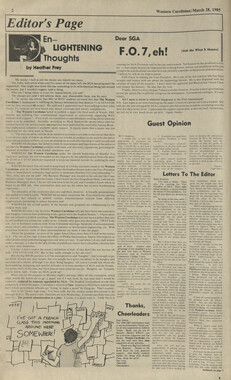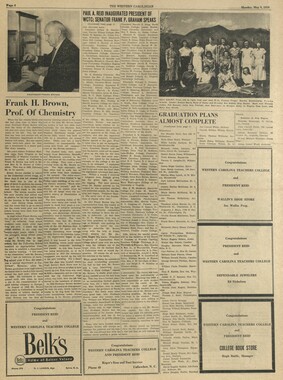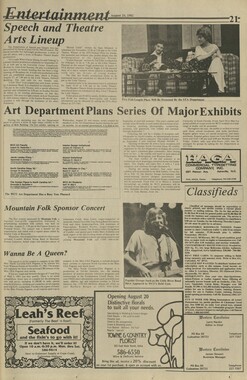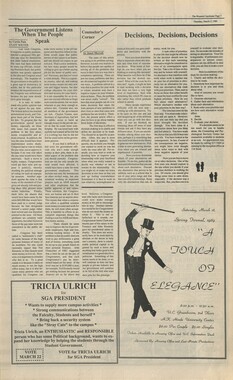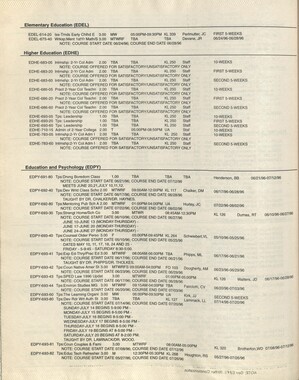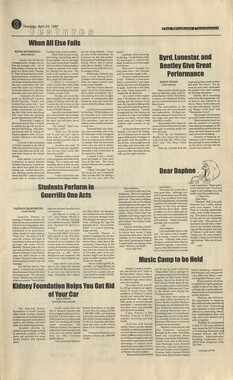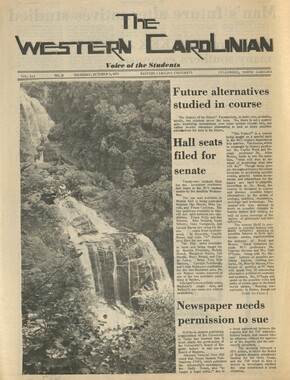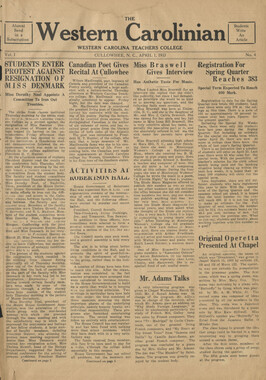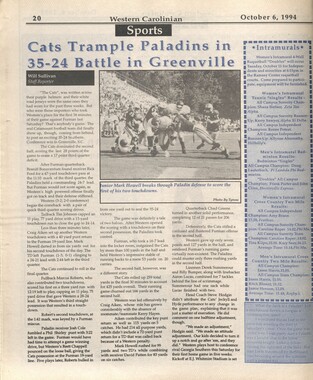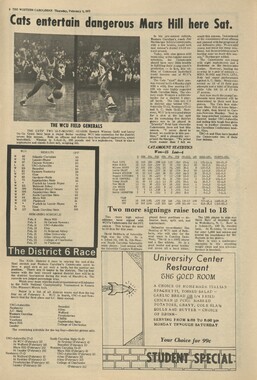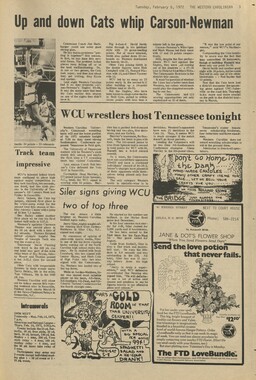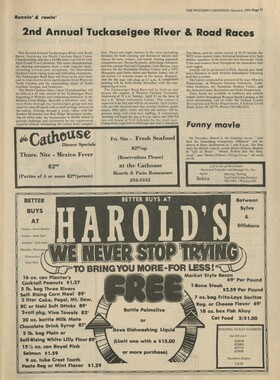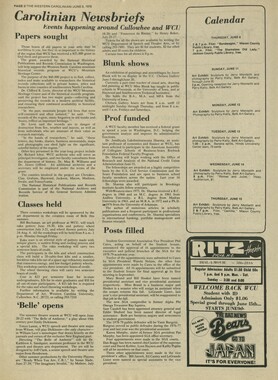Western Carolina University (20)
View all
- Canton Champion Fibre Company (2308)
- Cherokee Traditions (293)
- Civil War in Southern Appalachia (165)
- Craft Revival (1942)
- Great Smoky Mountains - A Park for America (2767)
- Highlights from Western Carolina University (430)
- Horace Kephart (941)
- Journeys Through Jackson (154)
- LGBTQIA+ Archive of Jackson County (26)
- Oral Histories of Western North Carolina (314)
- Picturing Appalachia (6772)
- Stories of Mountain Folk (413)
- Travel Western North Carolina (160)
- Western Carolina University Fine Art Museum Vitreograph Collection (129)
- Western Carolina University Herbarium (92)
- Western Carolina University: Making Memories (708)
- Western Carolina University Publications (2283)
- Western Carolina University Restricted Electronic Theses and Dissertations (146)
- Western North Carolina Regional Maps (71)
- World War II in Southern Appalachia (131)
University of North Carolina Asheville (6)
View all
- Allanstand Cottage Industries (62)
- Appalachian National Park Association (53)
- Bennett, Kelly, 1890-1974 (1388)
- Berry, Walter (76)
- Brasstown Carvers (40)
- Carver, George Washington, 1864?-1943 (26)
- Cathey, Joseph, 1803-1874 (1)
- Champion Fibre Company (233)
- Champion Paper and Fibre Company (297)
- Cherokee Indian Fair Association (16)
- Cherokee Language Program (22)
- Crowe, Amanda (40)
- Edmonston, Thomas Benton, 1842-1907 (7)
- Ensley, A. L. (Abraham Lincoln), 1865-1948 (275)
- Fromer, Irving Rhodes, 1913-1994 (70)
- George Butz (BFS 1907) (46)
- Goodrich, Frances Louisa (120)
- Grant, George Alexander, 1891-1964 (96)
- Heard, Marian Gladys (60)
- Kephart, Calvin, 1883-1969 (15)
- Kephart, Horace, 1862-1931 (313)
- Kephart, Laura, 1862-1954 (39)
- Laney, Gideon Thomas, 1889-1976 (439)
- Masa, George, 1881-1933 (61)
- McElhinney, William Julian, 1896-1953 (44)
- Niggli, Josephina, 1910-1983 (10)
- North Carolina Park Commission (105)
- Osborne, Kezia Stradley (9)
- Owens, Samuel Robert, 1918-1995 (11)
- Penland Weavers and Potters (36)
- Roberts, Vivienne (15)
- Roth, Albert, 1890-1974 (142)
- Schenck, Carl Alwin, 1868-1955 (1)
- Sherrill's Photography Studio (2565)
- Southern Highland Handicraft Guild (127)
- Southern Highlanders, Inc. (71)
- Stalcup, Jesse Bryson (46)
- Stearns, I. K. (213)
- Thompson, James Edward, 1880-1976 (226)
- United States. Indian Arts and Crafts Board (130)
- USFS (683)
- Vance, Zebulon Baird, 1830-1894 (1)
- Weaver, Zebulon, 1872-1948 (58)
- Western Carolina College (230)
- Western Carolina Teachers College (282)
- Western Carolina University (1794)
- Western Carolina University. Mountain Heritage Center (18)
- Whitman, Walt, 1819-1892 (10)
- Wilburn, Hiram Coleman, 1880-1967 (73)
- Williams, Isadora (3)
- Cain, Doreyl Ammons (0)
- Crittenden, Lorraine (0)
- Rhodes, Judy (0)
- Smith, Edward Clark (0)
- Appalachian Region, Southern (2399)
- Asheville (N.C.) (1917)
- Avery County (N.C.) (26)
- Blount County (Tenn.) (161)
- Buncombe County (N.C.) (1671)
- Cherokee County (N.C.) (283)
- Clay County (N.C.) (555)
- Graham County (N.C.) (233)
- Great Smoky Mountains National Park (N.C. and Tenn.) (510)
- Haywood County (N.C.) (3522)
- Henderson County (N.C.) (70)
- Jackson County (N.C.) (4692)
- Knox County (Tenn.) (25)
- Knoxville (Tenn.) (12)
- Lake Santeetlah (N.C.) (10)
- Macon County (N.C.) (420)
- Madison County (N.C.) (211)
- McDowell County (N.C.) (39)
- Mitchell County (N.C.) (132)
- Polk County (N.C.) (35)
- Qualla Boundary (981)
- Rutherford County (N.C.) (76)
- Swain County (N.C.) (2113)
- Transylvania County (N.C.) (247)
- Watauga County (N.C.) (12)
- Waynesville (N.C.) (73)
- Yancey County (N.C.) (72)
- Aerial Photographs (3)
- Aerial Views (60)
- Albums (books) (4)
- Articles (1)
- Artifacts (object Genre) (228)
- Bibliographies (1)
- Biography (general Genre) (2)
- Cards (information Artifacts) (38)
- Clippings (information Artifacts) (191)
- Crafts (art Genres) (622)
- Depictions (visual Works) (21)
- Design Drawings (1)
- Drawings (visual Works) (184)
- Envelopes (73)
- Facsimiles (reproductions) (1)
- Fiction (general Genre) (4)
- Financial Records (12)
- Fliers (printed Matter) (67)
- Glass Plate Negatives (381)
- Guidebooks (2)
- Internegatives (10)
- Interviews (812)
- Land Surveys (102)
- Letters (correspondence) (1013)
- Manuscripts (documents) (619)
- Maps (documents) (177)
- Memorandums (25)
- Minutes (administrative Records) (59)
- Negatives (photographs) (5835)
- Newsletters (1285)
- Newspapers (2)
- Occupation Currency (1)
- Paintings (visual Works) (1)
- Pen And Ink Drawings (1)
- Periodicals (193)
- Personal Narratives (10)
- Photographs (12976)
- Plans (maps) (1)
- Poetry (7)
- Portraits (1960)
- Postcards (329)
- Programs (documents) (151)
- Publications (documents) (2237)
- Questionnaires (65)
- Scrapbooks (282)
- Sheet Music (2)
- Slides (photographs) (402)
- Songs (musical Compositions) (2)
- Sound Recordings (796)
- Specimens (92)
- Speeches (documents) (15)
- Tintypes (photographs) (8)
- Transcripts (322)
- Video Recordings (physical Artifacts) (23)
- Vitreographs (129)
- Text Messages (0)
- A.L. Ensley Collection (275)
- Appalachian Industrial School Records (7)
- Appalachian National Park Association Records (336)
- Axley-Meroney Collection (2)
- Bayard Wootten Photograph Collection (20)
- Bethel Rural Community Organization Collection (7)
- Blumer Collection (5)
- C.W. Slagle Collection (20)
- Canton Area Historical Museum (2110)
- Carlos C. Campbell Collection (282)
- Cataloochee History Project (65)
- Cherokee Studies Collection (4)
- Daisy Dame Photograph Album (5)
- Daniel Boone VI Collection (1)
- Doris Ulmann Photograph Collection (112)
- Elizabeth H. Lasley Collection (1)
- Elizabeth Woolworth Szold Fleharty Collection (4)
- Frank Fry Collection (95)
- George Masa Collection (173)
- Gideon Laney Collection (452)
- Hazel Scarborough Collection (2)
- Hiram C. Wilburn Papers (28)
- Historic Photographs Collection (236)
- Horace Kephart Collection (861)
- Humbard Collection (33)
- Hunter and Weaver Families Collection (1)
- I. D. Blumenthal Collection (4)
- Isadora Williams Collection (4)
- Jesse Bryson Stalcup Collection (47)
- Jim Thompson Collection (224)
- John B. Battle Collection (7)
- John C. Campbell Folk School Records (80)
- John Parris Collection (6)
- Judaculla Rock project (2)
- Kelly Bennett Collection (1407)
- Love Family Papers (11)
- Major Wiley Parris Civil War Letters (3)
- Map Collection (12)
- McFee-Misemer Civil War Letters (34)
- Mountain Heritage Center Collection (4)
- Norburn - Robertson - Thomson Families Collection (44)
- Pauline Hood Collection (7)
- Pre-Guild Collection (2)
- Qualla Arts and Crafts Mutual Collection (12)
- R.A. Romanes Collection (681)
- Rosser H. Taylor Collection (1)
- Samuel Robert Owens Collection (94)
- Sara Madison Collection (144)
- Sherrill Studio Photo Collection (2558)
- Smoky Mountains Hiking Club Collection (616)
- Stories of Mountain Folk - Radio Programs (374)
- The Reporter, Western Carolina University (510)
- Venoy and Elizabeth Reed Collection (16)
- WCU Gender and Sexuality Oral History Project (32)
- WCU Mountain Heritage Center Oral Histories (25)
- WCU Oral History Collection - Mountain People, Mountain Lives (71)
- WCU Students Newspapers Collection (1744)
- Western North Carolina Tomorrow Black Oral History Project (69)
- William Williams Stringfield Collection (2)
- Zebulon Weaver Collection (109)
- African Americans (390)
- Appalachian Trail (35)
- Artisans (521)
- Cherokee art (84)
- Cherokee artists -- North Carolina (10)
- Cherokee language (21)
- Cherokee pottery (101)
- Cherokee women (208)
- Church buildings (167)
- Civilian Conservation Corps (U.S.) (110)
- College student newspapers and periodicals (1830)
- Dams (103)
- Dance (1023)
- Education (222)
- Floods (61)
- Folk music (1015)
- Forced removal, 1813-1903 (2)
- Forest conservation (220)
- Forests and forestry (1058)
- Gender nonconformity (4)
- Great Smoky Mountains National Park (N.C. and Tenn.) (181)
- Hunting (38)
- Landscape photography (10)
- Logging (103)
- Maps (84)
- Mines and mineral resources (8)
- North Carolina -- Maps (18)
- Paper industry (38)
- Postcards (255)
- Pottery (135)
- Railroad trains (71)
- Rural electrification -- North Carolina, Western (3)
- School integration -- Southern States (2)
- Segregation -- North Carolina, Western (5)
- Slavery (5)
- Sports (452)
- Storytelling (245)
- Waterfalls -- Great Smoky Mountains (N.C. and Tenn.) (66)
- Weaving -- Appalachian Region, Southern (280)
- Wood-carving -- Appalachian Region, Southern (328)
- World War, 1939-1945 (173)
Western Carolinian Volume 46 Number 28
Item
Item’s are ‘child’ level descriptions to ‘parent’ objects, (e.g. one page of a whole book).
-
-
News 5 April 22, 1982 Western Carolinian Center To Offer Alternative 10 th Annual Specials Olympics Held Despite Saturday's Rain He couldn't say how he felt, but the grin on 14-year-old Jim Ed Melton's face was broad and expressive. After giving his mother a hug, he turned and stood proudly as the official pinned a blue ribbon on his NC Special Olympics T-Shirt. Jim Ed, a special education student from Sylva, cannot speak as clearly as most children his age, but his face reflected pure delight as he competed and won first place in a softball throw event. He was one of more than 300 special education children and adults, who came from the Cherokee Indian Reservation and the counties of Cherokee, Clay, Graham, Jackson, Macon and Swain, to participate last Saturday in WCU's 10th Annual Special Olympics and Field Day Games. Opening ceremonies for the games began at 9:30 a.m. under overcast skies on WCU's outdoor track. Featured were the parade of participants, clowns and WCU's marching band, the releasing of baloons and traditional Special Olympics oath: "Let me win, but if I cannot win, let me be brave in the attempt." During the ceremonies, Fairview Elementary School of Sylva was awarded a stopwatch for the best school banner. Then following the carrying of the Special Olympics torch around the track by Lee Raney of Otto, the games got under way. But no sooner had the games begun, than scattered showers forced participants indoors to Reid Gymnasium, where they continued to compete for ribbons and a chance to advance to the N.C. Special Olympics, scheduled to be held May 28-30 at the University of North Carolina at Charlotte. As in years past, the Special Olympics were co-sponsored by the WCU Council for Exceptional Children and the Physical Education Major's Club under the auspices of the Departments of Special Education and Health, Physical Education and Recreation. This year, council advisor Jay Hikes accepted a plaque recognizing the council's contribution of $1,200 to the Special Olympics program. Special recognition also went to games co-directors. Dr. Helen Hartshorn of WCU and Dennis Proffitt of Fairview Elementary School, and Area Coordinator Anna Bolick of Peach Tree Elementary School. But highlighting the day's events, by far, were the individual competitive events which gave each participant a chance to win, no matter whether he or she came in first or last. In Special Olympics, there is no such thing as a loser. "1 think it was great,"said WCU Education Professor Dr. Jane Schulz at the end of the daylong games. "Special Olympics always is great, simply because the kids want to be here and they still win whether it rains or shines." Fears Of Future: Overpopulation by Greg Ryder In recent years there has been an increased concern over the problems of world over population. Dramatic pleas have been made in behalf of the starving children of numerous underdeveloped nations calling for massive foreign aid. The large majority would come trom the United States. These problems may be solved through better use of the resources that are currently available, and according to Lester Brown, of the World Watch Institute there is a tremendous need for redistribution of present resources. For many years population watchers have been telling us that the world is headed in the direction of massive over population. Today there is a different viewpoint being taken by persons who are abreast of the current figures. Lester Brown points to four separate areas of our environment that directly effect population. These ecosystems contribute to his ideas on what he calls the "Carrying Capacity of the World Environment." Brown breaks the areas down into the following divisions: Oceans—the oceans of the world are now being greatly overfished. Increased production in fish catching has not been able to keep pace with the market, and though there are now more ships than ever fishing the seas, their overall catch has failed to grow. Forests—in all the underdeveloped countries the majority of wood cut from the forests is used for fire wood. When a forest has been destroyed, the amount of time needed to re-forest the area is tremendous. Then erosion Droblems set in, harming the entire environment. Grasslands—the grasslands of the world are slowly being eroded away. The Sahara Dessert is expanding southward at a rate of a few miles per year, and the people there are being forced College students who want to capitalize on employment opportunities during the 1982 World's Fair and go to school this fall may find it impossible to do both. Many employers gearing up for the Fair plan to hire employees who can work full lime through Oct. 31, when the Fair ends. But full-time studies at colleges and universities will be well under way by that time, leaving some students in a difficult tossup between World's Fair employment and college study. The obvious choice for some will be employment, especially with the recession continuing to reduce what's already a critical shortage of summer jobs for youth. But that doesn't have to be the case. Students who want to work throughout the duration of the Fair and go to college this fall, too, can—by enrolling in a special program offered by WCU's Cherokee Center. This program works like this: □ From May through August, students should obtain information and register for courses that will begin in September. DOn Sept. 7, students begin taking an abbreviated schedule of classes. The classes are scheduled to meet for one hour every other Tuesday night in Cherokee (through October). oFrom November to Dec. 16, students complete their course work. During this period, classes will meet in Cherokee twice a week for three hours each meeting. All classes will be held during the day except one. "The beauty of this schedule," said Cherokee Center Director Dr. Lawrence Arney, "is that, through October, students can work any day or night of the week, except Tuesday nights when they need to go to classes. Then in November, when the fair is over, they can complete the semester with two months of intensive study. "In other ROTC Day Scheduled Helicopters, military equipment exhibits and a high school drill team competition featuring 23 units from North and South Carolina will highlight WCU's 1982 observance of ROTC Day on Saturday, May 1. The helicopters, expected to range in size from a relative small observation aircraft to a twin-engine, twin- rotor Chinook CH47 helicopter with 40,000-pound lifting capacity, will be on display on the intramural field adjacent to Belk Building. There will be weapons demonstrations and several activities which visitors may participate in. including the National Guard air rifle rn*rV«T«wrnriip training unit and rope suspension bridges constructed by the WCU Rangers. The drill team competition begins at 9 a.m. in Whitmire Stadium. A total of 23 junior ROTC units have entered and will compete in nine divisions—armed and unarmed platoon and squad infantry drill regulation, armed individual infantry drill regulation, platoon, squad and individual squad exhibition, and color guard. Goose Creek High School of Charleston, SC, which last year captured the Chancellor's Cup as the top overall team, will be defending its title. Additionally, first through third places will be awarded in each division. words," he said, "students in the program can take advantage of seasonal employment due to the World's Fair and still take classes to earn another semester toward a college degree." The program offers five three-hour credit courses, and students may take up to 15 semester hours of credit. The courses offered are: Dlntroduction to Speech Communications (STA 210), begins meeting 6:30-7:30 p.m. Tuesdays, Sept. 14, 28 and Oct. 19. Then meets 9 a.m. until noon, Mondays and Wednesday, Nov I - Dec. 15. Dlntroduction to Music(MUS 101), meets 7:30-8:30 p.m. 1 uesdavs, Sept. 14, 28 and Oct. 19. Then meets 9 a.m. until noon, Mondavs and Wednesdavs. Nov. I - Dec. 15. DTraveling and Tourism (PRM 460), meets 6:30- 7:30 p.m. Tuesdays, Sept. 7,21 and Oct. 9,26. Then meets 9 a.m. until noon, Tuesdays and Thursdays, Nov. 2- Dec. 16, except class will not be held Thursday, November 25. □ Man and Culture: Introduction to Cultural Anthropology (Anth 203), meets 7:30-8:30 p.m. Tuesdays, Sept. 7, 21 and Oct. 5, 26. Then meets 1-4 p.m. I uesdavs and Thursdays, Nov. 2 - Dec. 16, except class will not be held Thursday, Nov. 25. □ Environmental Geography (GEOG 101), meets 8:30-9:30 p.m. Tuesday, Sept. 7, 21 and Oct. 5, 26. Then meets 6:30-9:30 p.m. Tuesdays and Thursdays, Nov. 2 - Dec. 16, except class will not be held Thursday, Nov. 25. To register and obtain more information on the program, visit the WCU Cherokee Center on Acquoni Road in Cherokee, across from the Cherokee High School, from I until 4 p.m. weekdays. Or write WCU, Cherokee Center, Cullowhee, NC 28723. Or call 497- 7920 afternoons in Cherokee or 227-7151 weekdays in Cullowhee. Cherokee History Judaculla Still An Enigma to relocate. Croplands—many problems are arising from the overfarming of these lands. In the U.S. there are great problems due to the massive use of land for the production of export crops. The U.S. currently is the largest producer of food in the world and our land is showing signs of strain. Controlling the current population growth rate is now a factor that can be readily dealt with. In China, the government has instituted numerous programs to help ease the problem there. Newly married couples are offered such incentives as free health care and reduced rent on good housing if they practice good family planning. Families that have more than two children are penalized and lose face in their society. Also, in China, all forms of birth control, including abortion, are encouraged and government funded. Other large difficulties arise due to the mismanagement of land in many countries. In many countries where thousands die from starvation each year, huge, multi-national corporations own lands that are used to grow food for export to Europe and the U.S. In Nicaragua, the newly instituted revolutionary government has taken land away from the aristocratic landowners and returned it to the people. Many viewpoints are present concerning possible solutions to the problem. Some feel that there are resources available for the world to support itself now and cope with future growth. Others feel that their population will expand at such a rate that there will be no way to handle the added populus. unless dramatic steps are taken immediately. It is assured that there will be some need for concern, but no doubt a solution will be found. by Jim Buchanan ^^^^^^^^^^^^^^^^^^^^^ They say if you tilt your head and listen on a windy day, you can faintly hear drumbeats off in the distance... Jackson County houses an enigma. A stone, covered with markings that no one has been able to figure out to this very day, lies in the earth at the base of the Balsam Mountains. A description of it rests in the Smithsonian Institute, but the stone still raises many more questions than it answers. Judaculla rock has posed a problem to the scientific community for years. Dated pre-Cherokee, no one has been able to explain who left the mysterious writing on the stone, or what the original purpose of the rock was. Theories abound as to the rock's purpose: In the Cherokee translation of the Bible, Goliath is called Judaculla. The seven-fingered hand on the rock was formed, according to Cherokee legend, when the angry Judaculla was taking a swipe at some retreating Indians. Located some 6 miles from Cullowhee on Caney Fork, the rock is easily accessible to the public. Judaculla and the site on which it is located were donated to the government by Milas Parker in the 1930's on the provision that a road be built and maintained to Judaculla to give more people an opportunity to study the rock. James Mooney, of the U.S. Bureau of Ethnology, offered some observations on the Judaculla legend in a 1937 newspaper story appearing in the Asheville Citizen: "Judaculla Old Fields: A bald spot of perhaps a hundred acres on the slope of Tennessee bald (Tsui 'kalu Tsunegye), at the exteme head of the Tuckasiegee river, in Jackson County, on the ridge from which the lines of Haywood, Jackson, and Transylvania Counties diverge. The giant Tsulkalu. or Judaculla, as the name is corrupted by the whites, had his residence in the mountain, and according to local legend among the whites, said to be derived from the Indians, this bald spot was a clearing which he made for a farm. Some distance farther to the west, on the north bank of Caney Fork, about one mile above Moses Creek and perhaps 10 miles above Webster, in the same county, is the Judaculla rock, a large soapstone slab covered with rude carvings, which according to the same tradition, are scratches made by the giant in jumping from his farm on the mountain to the creek below." According to Mooney, Tsui 'kalu literally means "he has them slanting," in reference to the slant-eyed giant of legend. Cherokee legend states that Tsui 'kalu lived in Tsunegunyi (which later developed into Tuckasiegee) and was the great lord of the hunters. Dan Tompkins, a former Editor of the defunct Jackson County Journal, stated that years ago he was told the rock represented a treaty marker between the whites and the Indians, and that the lines on the rock show the location of the Meigs and Freeman lines. This treaty, however, was signed in 1793, and no one has been able to confirm or deny this theory. Milas Parker also had a theory, also formed mainly in conjunction with James Blythe, whose son later became Chief of the Cherokees. According to Blythe, the rock marks a peach treaty between Cherokee and Catawba Indians as long as the rock existed. Blythe studied the rock for two days and used his extensive knowledge of Cherokee legend to come to this conclusion. The Catawbas claimed the land to the top of the Smoky Mountains; the Cherokees claimed it to the top of the Blue Ridge; some of the bloodiest Indian battles, according to legend, were fought over this dispute. Blythe stated that the treaty was made before the coming of the white man, and was marked by a permanent rock (Judaculla). ****** There is no denying the rock has a mysterious appeal all its own. Judaculla is embeded firmly in the ground, facing east at an angle of 45 degrees. Approximately 40 feet in circumference, the rock has one line across the face which no other lines cross and may add some small proof of Blythe's theory, as it runs from northeast to southwest. Many figures are represented on the rock, including a wigwam, and a balsam fir tree, and a horned owl. Judaculla's giant hand is on the west side, and the lines on that side are unlike those on the other. Even the Indians and archaeologists cannot interpret the other strange markings. ****** Jackson County purchased the rock in 1959 and erected a shelter over it to preserve it from the effects of erosion. J. B. Parker, the owner at that time, sold it because he felt he could not give it the attention it deserved. Dr. Frank Speck was one of the few people who came close to deciphering the mysteries of the rock. His work, which he felt he was making great strides in, was cut short by his death, only to be carried on by Dr. John Whitoff. Both came close to unraveling the meaning, but no one yet has been able to complete the puzzle. And so, the enigma remains. The rock remains, a creation of great minds from an era completely lost from history, to baffle the greatest minds of today. And Judaculla will always be there, taunting us with a question that may never be answered. * .
Object
Object’s are ‘parent’ level descriptions to ‘children’ items, (e.g. a book with pages).
-
The Western Carolinian is Western Carolina University's student-run newspaper. The paper was published as the Cullowhee Yodel from 1924 to 1931 before changing its name to The Western Carolinian in 1933.
-
